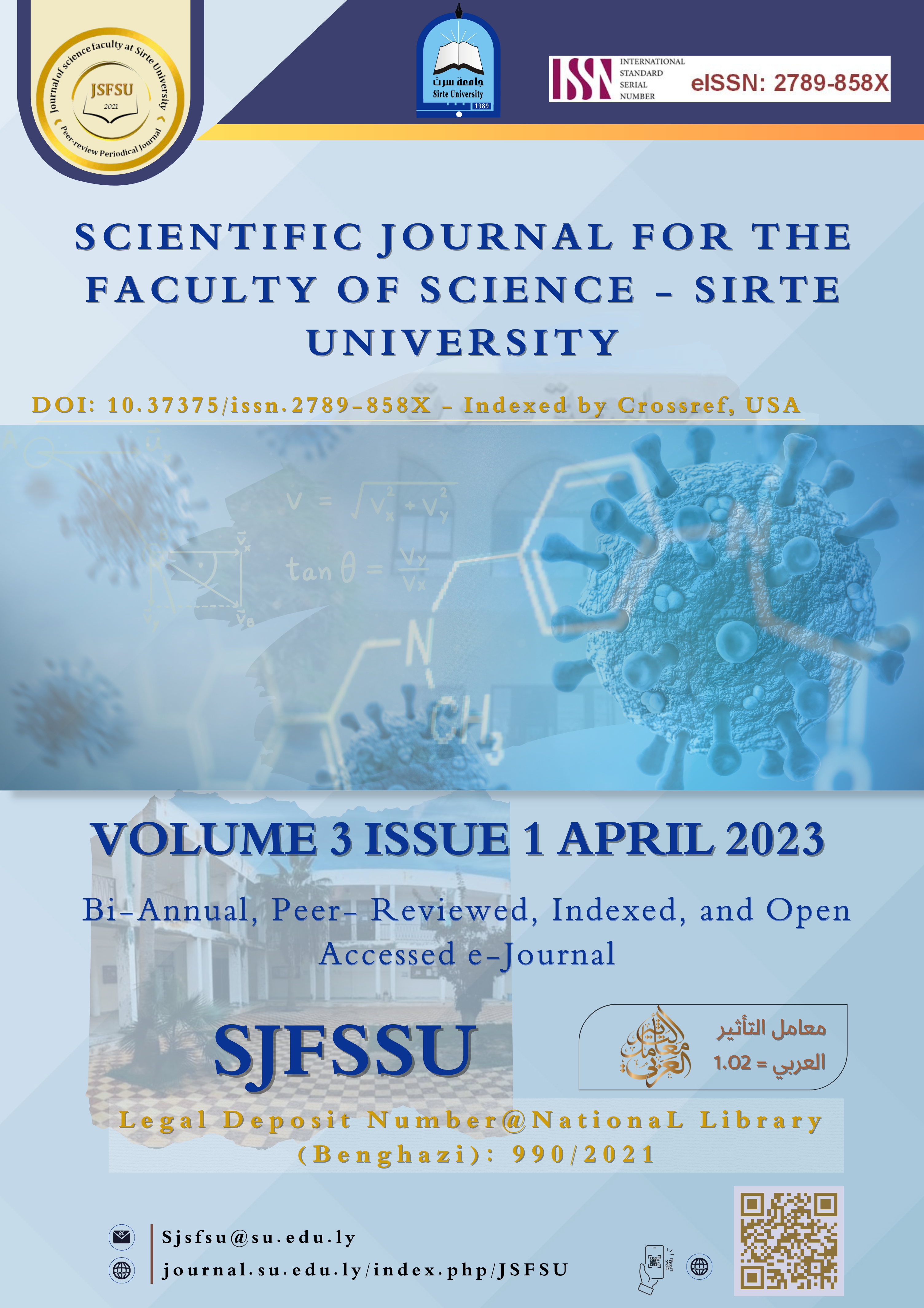A Study into Using Plant Extracts as Indicators for the Endpoint in the Acid-Base Titrations
DOI:
https://doi.org/10.37375/sjfssu.v3i1.149Keywords:
Acid-Base Titrations. Green Chemistry, Natural Indicators, Methyl Orange ; PhenolphthaleinAbstract
Acid-base titrations are the key part of volumetric analysis in the first year undergraduate chemistry practical program in Libya. Students are typically taught the procedures and skills necessary for acid-base titrations utilizing chemically synthesized indicators. Frequently utilized Synthetic indicators are sometimes difficult to obtain and highly hazardous to both people and aquatic life. Thus, the best option is to use natural dyes because it has been illustrated that some plant extracts exhibit the characteristics of synthetic dyes, making them usable for their use. Since this research emphasizes a return to green chemistry, it was necessary to search for alternative environmentally friendly indicators that are readily available, simple to prepare, and can be used to detect the endpoint of the reaction. The purpose of this article was to explore nine different types of aqueous extracts from various plants that can be used as indicators in acid-base titrations. The results showed that, similar to phenolphthalein, all of the investigated plant extracts are appropriate for strong-acid and strong-base titration. Moreover, hibiscus flower and cabbage leaf extracts are superior indicators for a strong-acid and strong-base titration to the synthesizers indicators. it was recommended that the use of these plant extracts as acid-base indicators should be combined in the teaching of acid-base titration. The amount of sodium hydroxide consumed at the endpoint were between 9.5 - 10 mL, while the pH of the solutions were between 6 - 9.7.
References
Abugri, D., Apea, O. and Pritchett, G. (2012). Investigation of a simple and cheap source of a natural indicator for acid-base titration: effects of system conditions on natural indicators. Green and Sustainable Chemistry, 02, 117-122.
Alejandre, S. A., Ripalda, A. O. The solvent extraction of rosa rosa (red rose) flower petals and its application as ph indicator. (BSChE). Eastern Visayas State University, Tacloban City/Republic of the Philippines.
Bhagat, V., Patil, R., Channekar, P., Shetty, S. and Akarte, A. (2008). Herbal indicators as a substituent to synthetic indicators,. International Journal of Green Pharmacy, 2, 162-163.
Bhise, S., Shinde, N., Surve, B,. Pimpodkar, V., and Shikalgar, S. (204). Acalypha wilkesiana as natural pH indicator. International Journal of Natural Products Research, 4, 33-35.
Housecroft C. and A. G. Sharpe, & , 3rd edition, . (2008). Inorganic Chemistry (3 ed.). England, UK: Educational ltd Prentice Hall.
Izonfuo, W. A., Fekarurhobo, G., Obomanu, F., & Daworiye, L. T. (2006). Acid-base indicator properties of dyes from local plants I: dyes from Basella alba (Indian spinach) and Hibiscus sabdariffa (Zobo). Journal of Applied Sciences and Environmental Management, 10. doi:10.4314/jasem.v10i1.17295
Izonfuo, W. F., G. Obomanu, F., and Daworiye, L. (2006). Acid-base indicator properties of dyes from local plants I: dyes from Basella alba (Indian spinach) and Hibiscus sabdariffa (Zobo). Journal of Applied Sciences and Environmental Management10(5-8).
Kadam, S., Yadav, A., Raje, V., and Waghmare K.,. (2013). Comparative study of natural and synthetic indicators. Der Pharma Chemic, 5, 296-299.
Kasture, A., Mahadik, R., Wadodkar, and More, H., . (2005). Textbook of Pharmaceutical Analysis. In (11th edition ed., Vol. 1). Maharashtra, India: Nirali Prakashan.
Mahjoub F, A. R. K., Yousefi M, Mohebbi M, Salari R. , . (2018 ). Pistacia atlantica Desf. A review of its traditional uses. phytochemicals and pharmacology. J Med Life, 3, 80-186.
Mendham, J., Denney, R., and Barness, J., Freeman, W. (2004). Quantitative Chemical Analysis (Vol. 6th edition). New Delhi, India.
Nuryanti, S., Matsjeh, S., Anwar, C.,Raharjo, T., Hamzah, B. . (2013). Corolla of Roselle (Hibiscus sabdariffa L.) as acid-base indicator. Eur. J. Chem., 4, 20-24.
Okoduwa, S. I. R., Mbora, L. O., Adu, M. E., & Adeyi, A. A. (2015). Comparative Analysis of the Properties of Acid-Base Indicator of Rose (Rosa setigera), Allamanda (Allamanda cathartica), and Hibiscus (Hibiscus rosa-sinensis) Flowers. Biochemistry Research International, 2015, 381721. doi:10.1155/2015/381721
Ologundudu, A., Ologundudu, A., Ololade, I., Obi, F. . (2009). Effect of Hibiscus sabdariffa anthocyanins on 2, 4- dinitrophenylhydrazine-induced hematotoxicity in rabbits. J. Biochem. Res., 3, 140-144.
Petrucci, R. H. (1972). General Chemistry; Principles and Modern Applications: Macmillan.
Pimpodkar, N. S., S., Shinde, N., Bhise, and Surve, B. (2014). Rhoeo syathacea and Allamanda cathartic extract as a natural indicator in acidity-alkalimetry. Asian Journal of Pharmaceutical Analysis, 4, 82–84.
Pradeep, J. a. D., K. . (2013). A novel, inexpensive and less
hazardous acid-base indicator. Journal of Laboratory ChemicalEducation, 1, 34-38.
Vaibhav, G. V., B., Prashant, D., Ganpatrao, N., Suresh, T., and Ashish, S. (2014). Study of Nerium odoratum as natural, economical and effective alternative to synthetic indicator and litmus paper. International Journal of Pharmaceutical Chemical Science, 3, 440.
Downloads
Published
How to Cite
Issue
Section
License
Copyright (c) 2023 Scientific Journal for Faculty of Science-Sirte University

This work is licensed under a Creative Commons Attribution 4.0 International License.














